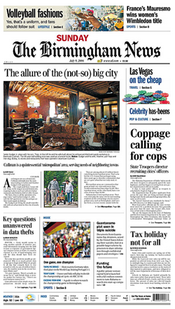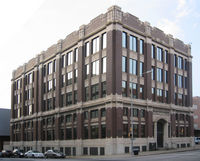Birmingham News
The Birmingham News is the principal daily newspaper for the Birmingham area and, with an average daily circulation of 148,827, the largest newspaper in Alabama. The paper is owned by Advance Publications.
History
The Birmingham News was launched on March 14, 1888 by Rufus N. Rhodes as The Evening News, a four-page paper with two reporters and $800 of operating capital working out of small, one-story building at 1st Avenue North and 21st Street. At the time, the city of Birmingham was only 17 years old, but was an already booming industrial city and a beacon of the "New South" still recovering from the aftermath of the Civil War and Reconstruction. Newspapers joined with industrial tycoons, academics and real-estate speculators in relentless boosterism of the new city. Rhodes was working as editor of the Daily Herald when he found his campaign for a viaduct spanning the "Railroad Reservation" dividing Birmingham's north and south opposed by his publisher. He determined to strike out on his own and launched the News with the slogan "Great is Birmingham and The News is its Prophet!" The "News Bridge" (21st Street Viaduct) was dedicated on July 4, 1891, and deemed by his paper the "grandest of all municipal achievements of great and glorious Birmingham."
The News circulation grew from 628 in 1888 to over 7,000 in 1891, when it became the largest daily in Alabama and won the contract to publish the General Laws of Alabama. In 1889, the name was changed from The Evening News to The Daily News and then, in 1895, The Birmingham News. 1895 also marked the paper's move down the street to a three-story brick building at 213 21st Street North. The newspaper continued to grow, reaching a circulation of 17,000 in 1909.
Staunchly progressive in its political stance, the News supported a straight-ticket Democrat platform in election seasons and championed progressive causes such as prohibition. The News led the drumbeat for the "Greater Birmingham" movement to annex suburban communities. The successful campaign caused the population of the City of Birmingham to grow from 40,000 in 1900 to 138,685 in 1910, at which time Birmingham was the third largest city in the South. That same year, Rhodes died and was succeeded by his vice-president and general manager, Victor H. Hanson.
Hanson, only 33 years old, was already an accomplished newspaperman, having at age 11 founded the City Item in Macon, Georgia which he sold four years later for $2,500. Hanson helped modernize the newspaper's format, tone and operations, oversaw an increase in subscriptions from 18,000 in 1910 to 40,000 in 1914 when he boldly claimed the title of "The South's Greatest Newspaper." In direct competition with the morning Age-Herald, the News began a Sunday edition in 1912.
In 1917 the News moved to a new six-story office building on the corner of 4th Avenue North and 22nd Street and a year later purchased the rival Birmingham Ledger, increasing the size of its staff to 748 and its circulation to 60,000.
From July 12 to August 14, 1945, publication of the News, along with the Birmingham Post and Age-Herald, was suspended due to a printers' strike.
In 1955, Samuel Newhouse purchased the News and its subsidiaries (WAPI-AM, WAFM-FM, TV station WABT, Huntsville radio station WHBS-AM, the Huntsville Times, and a freight company) for $18.7 million, a record at the time. Newhouse's publishing empire, now known as Advance Publications, still owns the newspaper, but it is The Birmingham News Company that publishes it.
In 1991, Ron Casey, Harold Jackson and Joey Kennedy received a Pulitzer Prize for Editorial Writing for their editorial campaign analyzing inequities in Alabama's tax system and proposing needed reforms.
In 1996, the News Corporation switched the publication times between the News and the Post-Herald, making the News a morning paper. Both papers published a joint weekend edition, distributed on Saturdays.
As of September 23, 2005, when the afternoon Birmingham Post-Herald ceased publication, the News remained as the only daily newspaper serving the city.
On August 10, 2006 the News cut the ribbon on their new headquarters building across 4th Avenue from their 1917 offices plant. The $25 million, 4-story, 110,000-square-foot brick and limestone building, designed by Williams-Blackstock Architects, borrows several details from the older building and is dramatically bisected by a glass atrium. In 2007 the paper's owner received approval from Birmingham's Design Review Committee to proceed with demolition of the older building to make way for a surface parking lot for employees.
Honors
In 1991, Ron Casey, Harold Jackson and Joey Kennedy received a Pulitzer Prize for Editorial Writing for their editorial campaign analyzing inequities in Alabama's tax system and proposing needed reforms.
In 2006 the News editorial staff were finalists for another Pulitzer for Editorial Writing for a series of editorials reversing the paper's longstanding support of the death penalty. That same year the paper won two Awards of Excellence from the Society for News Design for the paper's overall graphic layout.
In 2007, reporter Brett Blackledge won the Pulitzer Prize for Investigative Reporting for his series of articles exposing corruption in Alabama's two-year college system.
Features
The Wednesday edition features six subregional sections: East, Hoover, North, Shelby, South, and West covering local stories from those areas.
External links
- The Birmingham News website
- The Birmingham News on AL.com
References
- "On to Birmingham." (December 12, 1955). Time. [1]
- Jones, Emily, ed. (1988). The Birmingham News: Our First 100 Years. Birmingham: The Birmingham News.
- Jordan, Phillip (April 5, 2007). "All the News that's fit to lose." Birmingham Weekly.

